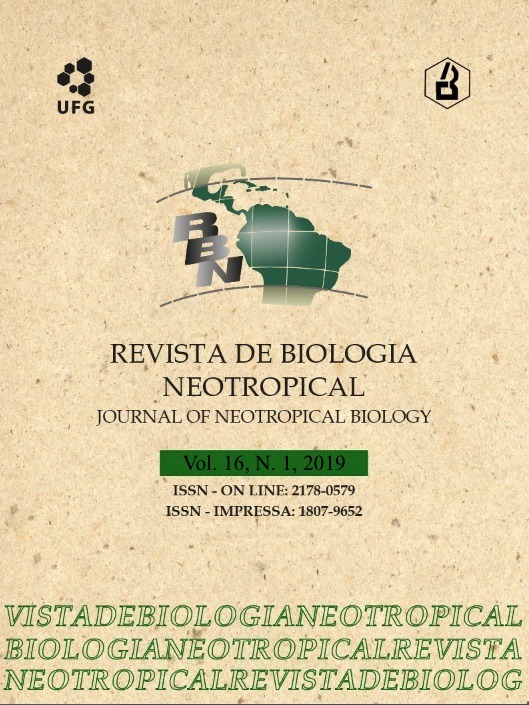Lateral migration of fishes and vulnerability of Chacororé Lake, Pantanal of Barão de Melgaço, Mato Grosso States, Brazil
DOI:
https://doi.org/10.5216/rbn.v16i1.46394Keywords:
System, lotic, lentic, Connectivity, Fish faunaAbstract
Lateral migrations are movements of fish shoals to and from lentic and/or lotic environments, in order to feed, reproduce or seek favorable survival conditions. This study was conducted in the corixo Manoel Isaac, which connects Cuiabá River to Chacororé Lake in the Pantanal of Barão of Melgaço, State of Mato Grosso. Fish were collected in the period of April-December, that included the seasons of receding water, drought and flood aiming to analyze the lateral migration of fish. It was observed that 12 species used the systems during dry and flood seasons, to feed (time of "lufada”) and to spawn (time of "spawning"), respectively. When the water level is higher, the fish pass between the river and the bay. At the beginning of the ebb (April), the catch is high, going up to July, and CPUEs decrease when the drought period begins (July) and there is a rise in the water level of the corixo at the end of September, second elevation in the catch is verified, however, the direction of movement of the majority of the species is in favor of the current, that is, movement of entrance in the bay. It was concluded that the lateral migration of fish between the Chacororé Bay and the Cuiabá River during the study presented tendencies of movement, for the greater catches, during the months of April to June (ebb) with a sense of movement of the bay and during the flood (October to December), the direction of the fish movement is river-bay.
Downloads
References
Bayley, P. B. 1973. Studies on the Migratory Characin Prochilodus platensis Homber, 1899 (Pisces, Characoidei) in the River Pilcomayo, South America, J. Fish Biol. 5:25-40.
Britski, H. A.; K. Silimon & B. S. Lopes. 2007. Peixes do Pantanal: manual de identificação. Corumbá: Embrapa Pantanal, 184 p.
Chapmam, D. W.; W. H. Miller; R. G. Dudley & R. J. Scully. 1971. Ecology os fish in the Kafue river. University of Idaho Tech. Rept. FAO, Rome, FI: SF/ZAM 11 Tech. Rep. 2, 66.
Diniz, G. L.; A. Krindges & M. O. Assunção-Jr. 2014. Processo evolutivo de contaminação da Baía de Chacororé. Proceeding Series of the Brazilian Society of Applied and Computational Mathematics, v. 3, n. 1, 2015. Trabalho apresentado no XXXV CNMAC, Natal-RN.
Fantin-Cruz I.; S. Loverde-Oliveira & P. Girard. 2008. Caracterização morfométrica e suas implicações na limnologia de lagoas do Pantanal Norte. Acta Sci. Biol. Sci. 30(2): 133-140.
Ferraz de Lima, J. A. 1986/87. A pesca no Pantanal de Mato Grosso (rio Cuiabá: importância dos peixes migradores) Acta Amaz. 16/17(único): 87-94.
Lowe-McConnell, R. H. 1977. Ecology of fish in Tropical waters. London, Edward Arnold Publishers, 62 p.
Junk, J. W. 1984. Ecology of the várzea, floodplain of Amazonian whitewater rivers. From Sioli, H. In the Amazon: limnology and landscape ecology of a might tropical river and its basin. Dordrech, Dr. Junk Publishers, 763 p.
Melo, A. P. G.; G. B. M. Alves & S. M. L. Oliveira. 2016. Uso e cobertura vegetal do solo da bacia do rio Mutum nas Zonas de Transição Aquático - Terrestre do Pantanal Norte. In: SIMPÓSIO DE GEOTECNOLOGIAS NO PANTANAL, 6., Cuiabá. Anais 6º Simpósio de Geotecnologias no Pantanal. Cuiabá: Embrapa-Inpe, v. 6, p. 111-121.
Pacheco, E. B. & C. J. Da-Silva. 2009. Fish associated with aquatic macrophytes in the Chacororé-Sinhá Mariana Lake system and Mutum River, Pantanal of Mato Grosso, Brazil. Braz. J. Biol. 69(1): 101-108.
Ribeiro, M. C. L. B. 1983. As migrações dos jaraquis (Pisces, Prochilodontidae) no rio Negro, Amazonas-Brasil. Dissertação de Mestrado- INPA/FUA, Manaus, 192 p.
Salomão, F. X. T. 1999. O rio Cuiabá como subsídio para a Educação Ambiental: Coletânea. Cuiabá, EdUFMT. p. 27-33.
Severi, W. 1999. O Rio Cuiabá como subsídio para a educação ambiental: coletânea. Cuiabá, EdUFMT, p. 65-100.
Sobrinho, J. A. F. & M. C. Alves. 2011. Variação temporal da assinatura espectral da baía de Chacororé no Pantanal de Mato Grosso. Anais XV Simpósio Brasileiro de Sensoriamento Remoto - SBSR, Curitiba, PR, Brasil, 30 de abril a 05 de maio de 2011, INPE, p. 5255.
Val, A. L. 1996. Surviving low oxygen levels: lessons from fishes of the Amazon. In: Val, A. L.; Randall, D. J. & Almeida-Val, V. M. F. (Ed.). Physiology and Biochemistry of the Fishes of the Amazon. Manaus, INPA, p. 59-73.
Welcomme, R. L. 1985. River fisheries Rome: FAO Fisheries Technical Papers, 330 p.
Zaniboni Filho, E. 1985. Biologia da reprodução do Matrichã, Brycon cephalus (Gunter, 1896) (Teleostei: Characidae). Dissertação de Mestrado- INPA/FUA, Manaus, 134 p.
Downloads
Published
How to Cite
Issue
Section
License
The expontaneos submmition of the manuscript automaticaly implies in the cession of all patrimonial rights for the Journal of Neotropical Bilogy (RBN) after publication. The autor allow the right of first publication of the article to the RBN, under Creative Commons Attribution 4.0 (CC BY-NC 4.0) Licence.
There are garanties for the authors to the authorial and moral rights, for each one of the articles published by RBN, with permissions:
1. The use of article and contents for the education and researches.
2. The use of the article and their contents, linking to the Article on the web site of the RBN, allowing the divulgation on:
- institutional closed web (intranet).
- open access repositories.
3. Preparation and divulgation of the other publication derived from the article and its content, if there is citation of the original publication by RBN.
4. Make printed copies in small quatinties for personal use.

















